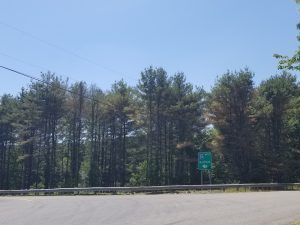 We are receiving reports of a rapid yellowing/browning and needle loss on all age and size of white pine trees in various parts of the state, in both the woods and along the roadsides. Tom Worthley, one of our Extension foresters states that we are observing a complex combination of needle fungi commonly referred to as “White Pine Needle Disease”, or WPND.
We are receiving reports of a rapid yellowing/browning and needle loss on all age and size of white pine trees in various parts of the state, in both the woods and along the roadsides. Tom Worthley, one of our Extension foresters states that we are observing a complex combination of needle fungi commonly referred to as “White Pine Needle Disease”, or WPND.
The University of Massachusetts published some information on this topic. According to UMASS:
“WPND is primarily caused by four fungal pathogens: Lecanosticta acicola (formerly Mycosphaerella dearnesii), Septorioides strobi, Bifusella linearis and Lophophacidium dooksii (formerly Canavirgella banfieldii). However, several other needle pathogens can also be found from stressed trees. Symptoms of WPND largely depend on the pathogen responsible, but their actions all result in premature needle shedding. It’s important to note that needle blight pathogens rarely kill trees by themselves. Yet, the annual cycle of infection and loss of older foliage creates a chronic stress that can severely weaken trees and exhaust stored resources. Of the fungi listed above, Lecanosticta and Septorioides are the most commonly encountered on both landscape and forest white pines, but the remaining fungi are locally abundant throughout their range.
WPND is favored by wet weather in May, June and July, when white pines are flushing new growth, followed by dry late season weather. Studies have shown that a changing climate in the northeast has contributed to WPND by creating conditions more conducive for disease development and spread. In particular, the region is experiencing more frequent rainfall events from May through July. The frequency of events does not necessarily mean an increase in total rainfall accumulation. Almost any rainfall event appears sufficient to induce spore production, dispersal and subsequent germination on newly developing needles. At the same time, overall precipitation has been increasing in the northeast during what is considered the cumulative growing season (April through September). Additionally, WPND is favored by high relative humidity at night and mild temperatures, conditions that are usually common in late spring and early summer throughout the northeast. The northeast has been experiencing an increase in average temperature during the cumulative growing season since the mid-20th century. The combined effects of increased temperature and precipitation have improved conditions for WPND pathogens. Spore dispersal primarily occurs from late May through August but the peak dispersal period occurs in mid-June in many locations. This peak spore dispersal period not only coincides with peak shedding of older, diseased needles but also with elongation of the current season’s needles. These young and immature needles are readily infected but will not show symptoms of WPND for many months. The long, latent period between infection and symptom development is common for many needle blight pathogens of conifers.”
Tom’s observations are consistent with Septoriodes strobi and also noted are an unusually high number of male cones this year, making twigs appear strange. More information from UMASS can be found at:
https://ag.umass.edu/landscape/fact-sheets/dieback-of-eastern-white-pine